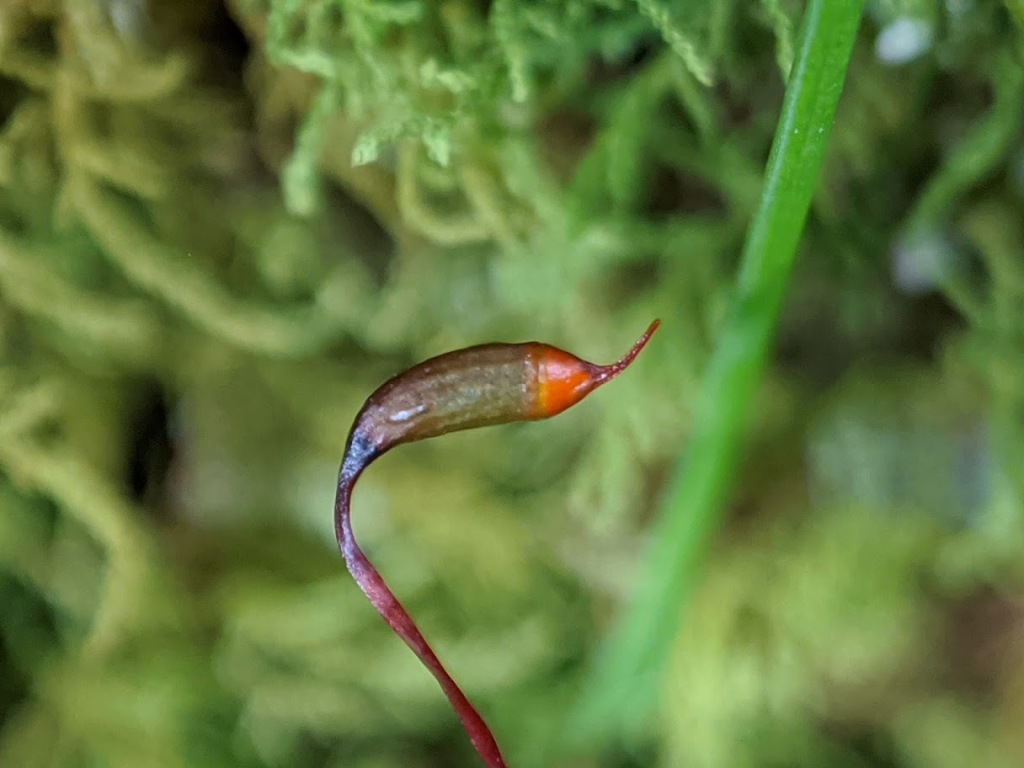Thuidiaceae
Autoicous (not in Victoria), synoicous (not in Victoria), or dioicous. Asexual propagules absent. Mats or wefts on soil, rocks, logs or trees. Stem creeping or ascending, 1–3-pinnate, with rhizoids produced ventrally where in contact with substrate, typically at the base and apex; paraphyllia present, usually abundant, simple or branched, filamentous to foliose; pseudoparaphyllia present, foliose; central strand present, rarely absent (not in Victoria). Leaves arranged around the stem and facing all directions, those of the stems and branches usually strongly differentiated by size and shape, strongly incurved from a patent base, appressed, or erect- to wide-spreading when moist, scarcely altered to becoming more erect, appressed, curved, or subsecund (not in Victoria) when dry, cordate, ovate or triangular, often with paraphyllia-like appendages at base; apex acute, acuminate, or rarely rounded, sometimes piliferous; costa single, extending to the apical half of the leaf or percurrent; margin crenulate, denticulate or serrulate, recurved near base, rarely plane throughout (not in Victoria) or incurved toward apex (not in Victoria), often with paraphyllia like appendages near base; laminal cells quadrate, rhombic, hexagonal, or short-rectangular, uni- or pluripapillose on abaxial or both surfaces, sometimes skewed to one side of the cell when elongate (not in Victoria); alar cells not or rarely differentiated (not in Victoria). Pleurocarpous. Capsules erect (not in Victoria) to pendent, straight or curved, exserted, operculate, with or without (not in Victoria) an annulus. Calyptra cucullate or rarely mitrate (not in Victoria), smooth or scabrous (not in Victoria), glabrous or hairy. Operculum conic (not in Victoria) or rostrate. Peristome double and alternate; exostome of 16 entire, shouldered teeth; endostome of 16 segments, rarely rudimentary (not in Victoria) or absent (not in Victoria), with a high or short (not in Victoria) basal membrane; cilia present, rarely absent (not in Victoria).
Worldwide except for Antarctica with around 17 genera and 125 species; two genera and five species in Victoria.
The circumscription of the Thuidiaceae presented here closely follows Touw (2001), with minor alteration that takes into account findings from molecular study. Under this circumscription, the family is distinctive and defined by a combination of well-branched stems with paraphyllia, papillose laminal cells, a single costa, and usually well-developed peristomes (Touw 2001; García-Avila et al. 2009). García-Avila et al. (2009) recommended a narrower circumscription restricted to Aequatoriella, Pelekium, Thuidiopsis, and Thuidium due to the placement of the type of Leskea, L. polycarpa Hedw., within the broadly defined Thuidiaceae of Touw (2001) in phylogenetic analyses of chloroplast DNA sequences. Additionally, Hylocomiopsis, included in the Thuidiaceae by Touw (2001), is not closely related to the remaining Thuidiaceae (García-Avila et al. 2009). The cardinal reason for separating Leskeaceae from the Thuidiaceae was a reduced peristome, which has been repetitively shown to not correspond well with groups resolved in molecular phylogenies (Gardiner et al. 2005). Apart from the slightlly reduced peristome, L. polycarpa demonstrates all the characteristic features of the Thuidiaceae previously mentioned, as well as several others that are characteristic of many of the Thuidiaceae such as differentiated branch and stem leaves. Consequently, it seems that Leskea could easily be accommodated within Thuidiaceae as so a broader circumscription of Thuidiaceae, including Leskea, but excluding Hylocomiopsis is described here.
 Spinning
SpinningGarcía-Avila, D.; De Luna, E.; Newton, A.E. (2009). Phylogenetic relationships of the Thuidiaceae and the non-monophyly of the Thuidiaceae and the Leskeaceae based on rbcL, rps4 and the rps4-trnS intergenic spacer. The Bryologist 112: 80–93.
Gardiner, A.; Ignatov, M.; Huttunen, S.; Troitsky, A. (2005). On resurrection of the families Pseudoleskeaceae Schimp. And Pylaisiaceae Schimp. (Musci, Hypnales). Taxon 54: 651–663.
Touw, A. (2001). A review of the Thuidiaceae (Musci) and a realignment of taxa traditionally accommodated in Thuidium sensu amplo (Thuidium Schimp., Thuidiopsis (Broth.) M.Fleisch., and Pelekium Mitt.), including Aequatoriella gen. nov. and Indothuidium gen. nov.. Journal of the Hattori Botanical Laboratory 90: 167–209.


